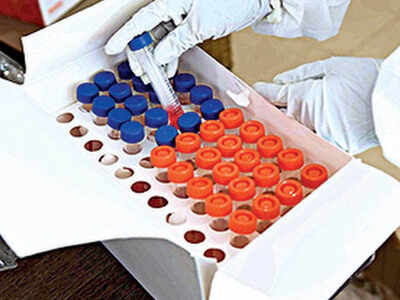
AHMEDABAD: Tuesday saw Gujarat surpass grim Covid landmarks – the state recorded highest ever daily tally of 1,026 cases, becoming the seventh state in India to cross 50,000 total cases. The state also recorded 34 Covid-19 deaths, highest in the past 40 days pushing the death toll to 2,201, the fourth state in the country to record over 2,000 mortalities.
Right from the very beginning, high corona mortality in Gujarat has baffled experts who even voiced concern that virus strain in the state might be different from the one afflicting people in other parts of the country. Now, a study carried out by state-funded Gujarat Biotechnology Research Centre (GBRC) has found that the genetic profile of Covid-19 in Gujarat is indeed different from the average profile found in India and the world.
Out of six clades of virus found in Gujarat, GH clade was prevalent in 51.8%, followed by G in 38.5% of the samples. Indian composition based on the submissions so far reveal that O clade is dominant, followed by GR, GH and G. Meanwhile, globally GR clade is found in 31.1% of the samples, followed by G in 24.8% and GH clade in 22.6%.
The study found two specific mutations-- A23403G and C14408T--that were present in over 95% of the deaths that may be linked to the high death rate of Gujarat. In the first week of June, the state had a death rate of 6.2% compared to 2.8% in India. On July 20, the mortality rate had dipped to 4.4% but it remained higher than the national average of 2.4%.
Focus on mortality numbers
The unpublished paper ‘Genomic variations in SARSCoV-2 genomes from Gujarat: Underlying role of variants in disease epidemiology’ was undertaken to understand the high mortality rate of the state and genetic variations in the virus. The team of 15 researchers led by GBRC director Prof Chaitanya Joshi and joint director Dr Madhavi Joshi analysed 361 coronavirus samples collected from 38 locations of 18 districts in Gujarat.
The paper says that a good 91 mutations novel to the state were found. Of 18 total variants found from the state, seven had more than 50% prevalence. Two mutations – A23403G and C14408T — were found in 98% and 95% of the deceased patients in Gujarat. This could mean that these mutations were rendering a more severe form of disease which was difficult to treat. Moreover, two mutations - G25563T and C28854T in Orf3a and N genes respectively - were found to be dominant in the overall genetic profile exclusive to Gujarat.
The find is important as the Orf3a gene encodes a protein involved in the regulation of inflammation, antiviral responses, and apoptosis, said a researcher. “The findings would help us understand the regionspecific variants and mutations that can help develop vaccination and quicker identification of drug repurposing candidates,” said a GBRC official.
‘The female patients in Gujarat dataset were observed to be at significantly higher death rate as compared to global dataset in deceased and recovered patients… The results indicated a significantly higher mortality rate at the age groups of 41-60 and over 60 years in Gujarat compared against age groups in the global dataset,’ mentioned the paper.
Right from the very beginning, high corona mortality in Gujarat has baffled experts who even voiced concern that virus strain in the state might be different from the one afflicting people in other parts of the country. Now, a study carried out by state-funded Gujarat Biotechnology Research Centre (GBRC) has found that the genetic profile of Covid-19 in Gujarat is indeed different from the average profile found in India and the world.
Out of six clades of virus found in Gujarat, GH clade was prevalent in 51.8%, followed by G in 38.5% of the samples. Indian composition based on the submissions so far reveal that O clade is dominant, followed by GR, GH and G. Meanwhile, globally GR clade is found in 31.1% of the samples, followed by G in 24.8% and GH clade in 22.6%.
The study found two specific mutations-- A23403G and C14408T--that were present in over 95% of the deaths that may be linked to the high death rate of Gujarat. In the first week of June, the state had a death rate of 6.2% compared to 2.8% in India. On July 20, the mortality rate had dipped to 4.4% but it remained higher than the national average of 2.4%.
Focus on mortality numbers
The unpublished paper ‘Genomic variations in SARSCoV-2 genomes from Gujarat: Underlying role of variants in disease epidemiology’ was undertaken to understand the high mortality rate of the state and genetic variations in the virus. The team of 15 researchers led by GBRC director Prof Chaitanya Joshi and joint director Dr Madhavi Joshi analysed 361 coronavirus samples collected from 38 locations of 18 districts in Gujarat.
The paper says that a good 91 mutations novel to the state were found. Of 18 total variants found from the state, seven had more than 50% prevalence. Two mutations – A23403G and C14408T — were found in 98% and 95% of the deceased patients in Gujarat. This could mean that these mutations were rendering a more severe form of disease which was difficult to treat. Moreover, two mutations - G25563T and C28854T in Orf3a and N genes respectively - were found to be dominant in the overall genetic profile exclusive to Gujarat.
The find is important as the Orf3a gene encodes a protein involved in the regulation of inflammation, antiviral responses, and apoptosis, said a researcher. “The findings would help us understand the regionspecific variants and mutations that can help develop vaccination and quicker identification of drug repurposing candidates,” said a GBRC official.
‘The female patients in Gujarat dataset were observed to be at significantly higher death rate as compared to global dataset in deceased and recovered patients… The results indicated a significantly higher mortality rate at the age groups of 41-60 and over 60 years in Gujarat compared against age groups in the global dataset,’ mentioned the paper.

Coronavirus outbreak
Trending Topics
LATEST VIDEOS
More from TOI
Navbharat Times
Featured Today in Travel
Quick Links
Kerala Coronavirus Helpline NumberHaryana Coronavirus Helpline NumberUP Coronavirus Helpline NumberBareilly NewsBhopal NewsCoronavirus in DelhiCoronavirus in HyderabadCoronavirus in IndiaCoronavirus symptomsCoronavirusRajasthan Coronavirus Helpline NumberAditya ThackerayShiv SenaFire in MumbaiAP Coronavirus Helpline NumberArvind KejriwalJammu Kashmir Coronavirus Helpline NumberSrinagar encounter
Get the app









